Everything You Want To Know About LEGO Gears
/Gears. It’s what Technic is all about (apart from pneumatics 😉). When LEGO first created gears in a Samsonite set back in 1965, there were only four different sizes and the gears were all similar. Fast forward to 2024, and LEGO has produced gears in nearly 50 different shapes and sizes! Let me take you through the history of LEGO gears. Along the way, you’ll learn about different types of gears, why so many have teeth in multiples of four, and see some of the clever design choices in the LEGO gear family.
Early Days
The first LEGO gears, the Samsonite gears back in 1965, had no axles. They were simply round plates you could put on wheels. Five years later, the Expert Builder gears looked very similar, but they now have axles. A big improvement when you want to turn something! These gears have long, thin teeth, almost like spokes. They were designed to work both side by side, and around corners.
Expert Builder gears introduced in 1970.
While they look quite similar, the two families are not compatible. See, for gears to mesh and to work together, they must have the same size teeth. But how do you measure gear teeth, I hear you ask? Let me explain. And explaining means getting technical about gears. You’d be surprised how many technical terms for gears there are!
Here Comes The Science Bit
Ready for a little math and physics? Let’s start with some definitions. The diameter of the disc at the centre of a gear is the root diameter. The diameter to the outer tip of the teeth is appropriately called tip diameter. Between those two is the diameter we need: the pitch or reference diameter. This is the diameter to the point on the teeth where they meet their partner gear. That’s all very abstract, so let’s use these Samsonite 14-tooth gears to explain:
Two Samsonite 14 tooth gears, 4 studs apart.
Pink is the root diameter, green is the tip diameter, and orange is the pitch diameter. You can see that the pitch diameter is the same as the distance between the centres, in this case, 4 studs.
We now have a measurement for the size of the gear and the number of teeth. There are two ways to combine them to define the size of the teeth. The Metric Module is the diameter (in mm) divided by the number of teeth. The imperial unit is the opposite (or reciprocal, to use the correct mathematical term); Diametral Pitch is the number of teeth divided by the diameter (in inches).
For this article, I will use a variation of the Diametral Pitch, using the radius instead of the diameter and measuring in studs rather than inches. So our Radial Pitch for this gear is 14 / 2 = 7. You can repeat this calculation for the other Samsonite gears, but the answer will always be 7.
Now let's look at the number of teeth on LEGO gears. The Samsonite gears have a Radial Pitch of 7, and they exist with 14, 21,35, and 42 teeth. The Expert Builder gears have a slightly different Radial Pitch of 6, and their family consists of 9, 15 and 21 tooth gears. Notice the pattern?
The Big Bang
In 1977, LEGO launched the Technic system with a lot of new parts—including new gears. After learning from the earlier short-lived gear families, the LEGO designers decided to use a very different gear design for the new theme: involute gears. (If you like math and/or engineering, I’d recommend reading the Wikipedia article.) Involute gears are a very elegant solution. The initial set of gears in 1977 comprised 8, 24 and 40-tooth gears. It won’t surprise you then that the Radial Pitch of this family is 16.
In 1979, LEGO added the 16-tooth gear to the family. That seems an obvious choice; 8, 16, 24... But this gear has a pitch radius of 1. So, to make it mesh with any of the other gears, the distance would have to be 1.5, 2.5 or 3.5 studs. The 1x1 Technic brick didn’t exist yet, so half-stud offsets were not easy in Technic. That’s why for a long time, the 16-tooth gears didn’t play with the others. Instead, they were only used in pairs, with chains, or for rack and pinion steering.
Let’s go back to the math and turn our formula around. If the Radial Pitch is the number of teeth divided by the pitch radius, then the pitch radius is the number of teeth divided by the radial pitch. In other words, to find the pitch radius of a LEGO Technic gear, take the number of teeth, and divide by 16.
The distance between two gears is the sum of their pitch radii. As you can see in the image above, two 16-tooth gears with a pitch radius of 1 each will sit 2 studs apart. A 24-tooth and a 40-tooth gear, with pitch radius 1.5 and 2.5, will sit 4 studs apart.
Turning A Corner
So far we’ve looked at spur gears. A spur gear is a straight gear; it is basically a cylinder with teeth on its side; the teeth are perpendicular to the axle, and two spur gears work on parallel axles. To “go around a corner” you need a crown gear or a bevel gear. Crown gears have teeth on the surface of the disc, while bevel gears are cones with teeth on them. Both work on axles that are at an angle. For obvious reasons, all LEGO bevel gears are designed for 90-degree angles.
Bevel, Crown and Spur gear, LEGO style.
The original gear family had a 24-tooth crown gear, but because it doubled as a spur gear, the design was compromised. It kind of did the job, but it wasn’t great. In 1980, the second Technic Supercar had a real differential between the rear wheels (for turning corners, heh), and that required bevel gears which arrived in the shape of the 14-tooth thin bevel gear that worked both inside the differential and outside, connecting to the 28-tooth crown gear on the differential body.
Differential with 14 tooth bevel gears, and two 14 tooth bevel gears meshed at a 90 degree angle.
The differential was a fantastic new part, and it was great to have the small bevel gears making the 90-degree gearing possible in a much smaller space than was possible with the 24-tooth crown gear, but you probably noticed something is a bit off... 14 is no multiple of 8, or even 4. The gears were thin, less than half a stud, which made it difficult to secure them sometimes. The differential looked like a spur gear with the crown teeth added as an afterthought. With its radial pitch of 1.75 it is difficult to use with any of the other gears we had at that time. In fact, I don’t think the straight gear was ever used in a set.
Steady As She Goes
Once the bevel gear and the differential were added, Technic had a good selection of gears.
Driving Ring with Clutch Gear
Throughout the 1980s and most of the 90s, the “gear palette” changed very little. In 1985, a worm gear was introduced, and in 1990, a turntable with a 56-tooth gear around the outside joined the family. In 1994, another Technic Supercar, the 8880, introduced a vastly improved way of creating gearboxes with sliding gear selectors. They required special gears that could spin freely on an axle, but with a “clutch” to engage with the selector rings.
The differential housing was also replaced. The crown teeth disappeared and instead it had a 16-tooth gear on one side and a 24-tooth gear on the other. It also had the same clutch to work with the gear selectors, but as far as I know this was never again used in a set.
These new elements added to the gear palette, but they remained “in the family”—apart from the odd-ball bevel gear, all the gears were in the eight-times-table family. Until…
Technic Supercar 8880 from 1994. Image via Brickset.
Meet The Extended Family
The biggest change in Technic, as far as gears are concerned, came in 1999—but we got a first glimpse in 1995. That awkward 14-tooth bevel gear was replaced with a slightly smaller, slightly thicker 12-tooth bevel gear. No big deal, right? But look a bit closer and you’ll see why this is a much better gear. For a start, it’s as thick as a half bushing, making it easier to “fill” an axle. It’s much stronger because the teeth sit properly on the cone surface. Finally, it’s more in-system; its radial pitch of 0.75 matches with... err... no other existing gear at the time, just like the 0.875 of the 14-tooth gear. So, just like the 16-tooth gear, for a few years, the new 12-tooth bevel gears could only play together.
That all changed in 1999 with the introduction of the 20-tooth bevel and the 12 and 20-tooth double-bevel gears. The smart thing about these double-bevel gears is that they have a spur gear between the two bevels. In a way, we’ve come full circle. We are back with gears that can be used both straight and at a 90-degree angle. The new generation is much smaller and better designed than the class of ‘65.
Left to right: Two old 14t bevel gears, two new 12t bevel gears, 12t double bevel gear and 16t spur gear.
There was only one problem: the radial pitch of the new family members is 0.75 for the 12-tooth gear and 1.25 for the 20-tooth gear. That means they work well together sitting two studs apart, just like the 8 and 24 tooth gears, and two 16 tooth gears combined (notice how the pair adds up to 32 teeth every time?).
Now how do you get the spur and the double-bevel family to play nice? Square roots! If you have two axles two studs apart in one direction and one stud in the other, then according to Pythagoras, their distance is the square root of 5, or 2.236. That’s pretty close to 2.25 for the 12-tooth gear from one family to mesh nicely with the 24-tooth gear from the other. Or a 20-tooth with a 16-tooth, or an 8-tooth with a 28-tooth. The 20 and 24-tooth gears in the image below have an ideal distance of 2.75 studs (1.5 + 1.25). The distance here is 2.83—slightly longer. It works, but there’s a bit more slack.
Mixing the two gear families with a little help from Pythagoras
With these new members added to the family, calm returned, and for the next 15 years, again very little changed. The turntable was changed to a studless model in 2004, and in 2012 it got a baby sister with 28-teeth. A 36-tooth double bevel gear was added in 2005, and a 20-tooth bevel gear with a pin hole arrived in 2010. This one is especially useful in combination with linear actuators; the axle that the actuator rests on no longer needs to turn, resulting in smoother operation with much less friction. In 2008, the differential housing was once again changed, going back to 28-teeth and a bevel gear.
A New Period of Change
From 2015, the changes picked up pace with new Technic elements arriving nearly every year. In 2015, the turntable grew to 60 teeth and received a bevel. It also lost its inner 24-tooth ring. In 2016, the round gear rack arrived, followed by a shorter (1 stud) worm gear in 2017. In 2018, we had a 20-tooth double bevel gear with clutch, and in 2019 came a 28-tooth double bevel. In 2020, a radical new differential was introduced, and that brought a 28-tooth double bevel gear with pin hole to be used on the side of the differential housing.
After a short break in 2021, the next year delivered a number of updates that seem to be aimed at stronger gears. The turntable lost its bevel again. Two strange bevel gears arrived for the differential; one that fits on the housing, this time with 22 teeth, and the other with 14 teeth to mesh with it. These two gears are thicker than other bevel gears and have a slightly different design. They won’t work with any other gears, or even with themselves. There were also new straight versions of the 12 and 20-tooth gears. In 2023, the smaller curved gear rack arrived, and in 2024, the 45-degree option for the knob gear.
Whew, that’s a lot. And breathe…
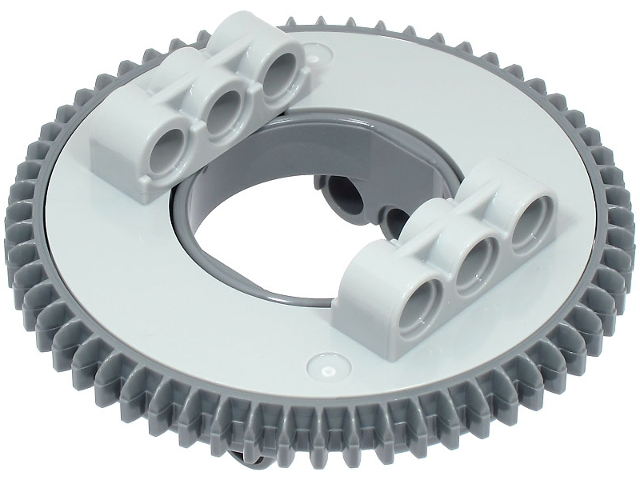
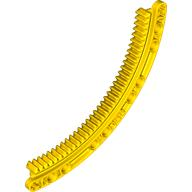
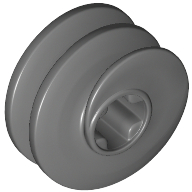
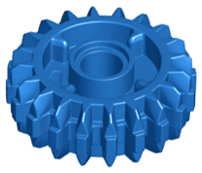
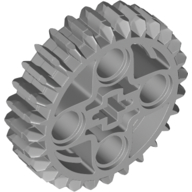

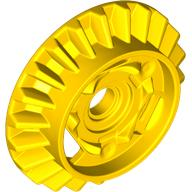
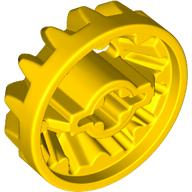
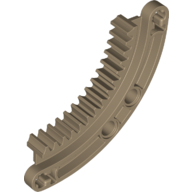
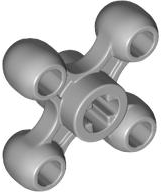
Alongside the development of the gear family, there have also been some one-off designs. For the big mobile crane, a sliding 8-tooth gear was developed that hasn’t appeared in another set since then. A timing gear was created for the Barcode Multi-Set. Apart from a few Dacta sets, it’s mostly been used for cosmetic purposes since then. A similar ratchet wheel was introduced with the new gearbox in the large Yamaha motorbike in 2023. (I expect to see this part again in the future.) The Star Wars Hailfire Droid has two large wheels with 168 teeth inside. The teeth didn’t really serve a purpose in the set, and the wheels have never been seen again.
And then there’s the curious case of part 15457, a 1L worm screw with an axle holder at each end. BrickLink shows it in the inventory of three sets, but Brickset doesn’t differentiate the part and instead lists 4716, the regular 2L worm screw. Sets 42026 and 42027 both contain a worm screw, but neither uses it for the main model. Instead, a single one is used in a model you can build by combining the two sets. The third set, 42023, shows the normal worm gear in the inventory (element 6037533 at the end of book one), while the instructions actually show the elusive part 15457 (page 35/36 of book three).
Wormd screws; old 2L, one-off 3L, new 1L bigger diameter.
From 1997 until 2018, we also had a 24-tooth clutch gear aimed at protecting motors. It works like a normal gear until the torque gets too big, then they slip. That allows a motor to keep turning if a mechanism jams, preventing it from damage. In 2019, it was replaced by a clutch without a gear, still providing the same motor protection.
Odds and Ends
We have arrived at the very end of our gear round-up so it is time to talk about the outliers. I briefly mentioned knob wheels earlier. They are a special design, strong, but bulky, and they don’t work with anything else. In 2024, a second version was introduced, with the axle hole 45 degrees offset compared to the original. These gears are a bit easier to align and generally used in simpler sets.
In 2019, LEGO created a new range of gears, nicknamed the splat gears. Much like the old Samsonite gears, they are plates with pin holes that need to be placed on turntables or wheels. These splat gears are produced in bright colours and are aimed at making movement easy. While they have the same Radial Pitch as the knob wheels, the tooth/knob design is slightly different (so they don’t work well together).
Splat gears on the left, Knob wheels on the right. They don’t meet nicely in the middle…
Oh, I almost forgot to mention that even Duplo has gears! From 1993 until 2015, there was Duplo Technic with gears like the original Technic ones: 8, 24, and 40-tooth gears and a crown wheel. Since 2017, Duplo has had its own splat gears.
Looking at the rest of the catalogue, I also skipped over the straight gear racks and sprockets; they are not gear wheels. Bionicle also introduced parts with partial gears. Should they count? The gear segments are “in-system”; they match the 24-tooth gear and the 12-tooth double bevel gear. But maybe that is a topic for another day…
Some gearish Bionicle parts
That’s an overview of LEGO gears from 1965 until today, representing almost 60 years of innovation. So where will we go from here? Will LEGO keep adding gear parts? Maybe we’ll finally have the missing link: a 32-tooth gear! Will there be more “out-of-system” gears like the current 14 and 28-tooth thick bevel gears?
One thing is for sure: I’m not done writing about Technic! Keep an eye out for the next article, where I’ll explain more about how you can use these gears and other Technic parts in your MOCs—and more than just decoratively.
Best of BrickNerd - Article originally published May 10, 2024.
Do you have a favorite LEGO gear? Or a preferred gear ratio? Let us know in the comments below!
Do you want to help BrickNerd continue publishing articles like this one? Become a top patron like Marc & Liz Puleo, Paige Mueller, Rob Klingberg from Brickstuff, John & Joshua Hanlon from Beyond the Brick, Megan Lum, Andy Price, Lukas Kurth from StoneWars, Wayne Tyler, Dan Church, and Roxanne Baxter to show your support, get early access, exclusive swag and more.
































